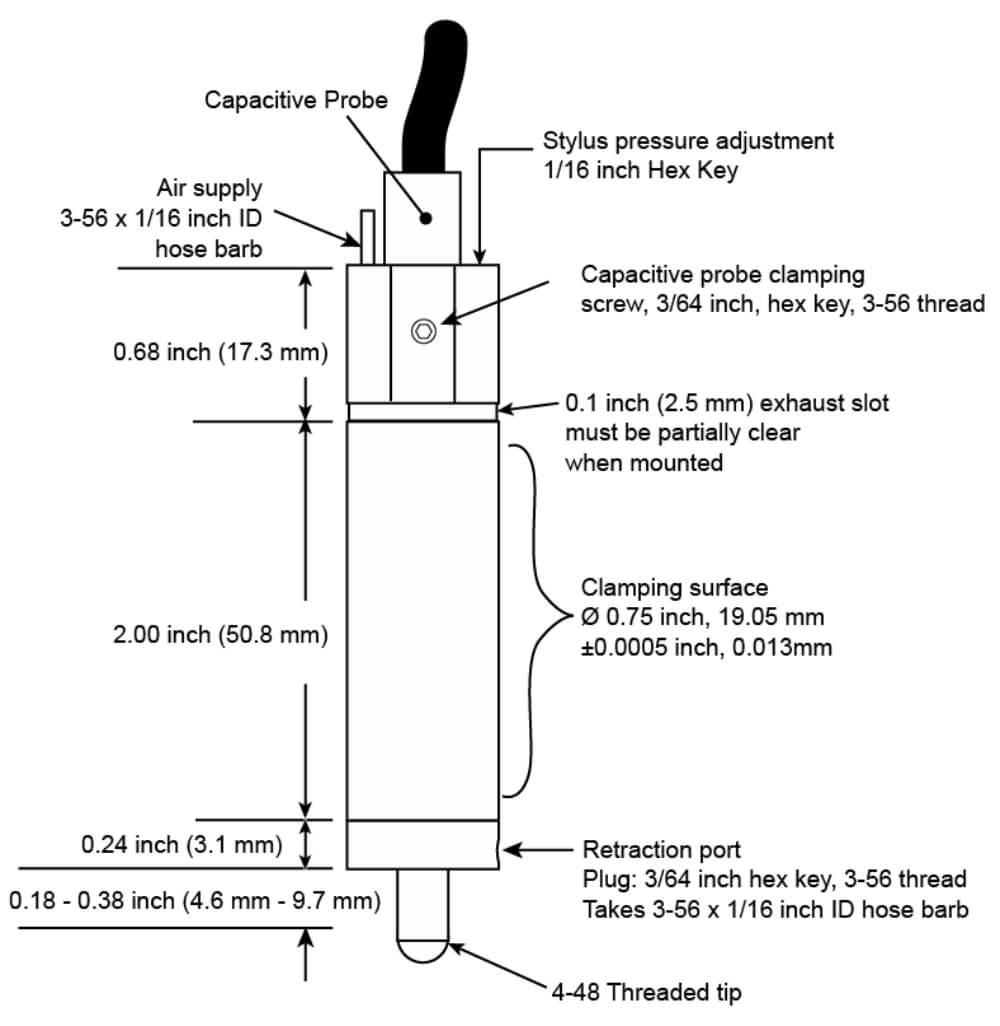
USER’S GUIDE for the
MM190 – Meter and Function Module
TABLE OF CONTENTS
- Approvals and Safety Considerations
- Helpful Technical Support Documents Online
- MM190 Meter and Function Module
- Elite Series Enclosures
- Accessories
Approvals and Safety Considerations
The Elite Series is compliant with the following CE standards:
Safety: EN 61010-1:2010
EMC: IEC 61326-1:2013, IEC 61326-2-3:2013
To maintain compliance with these standards, the following operating conditions must be maintained:
- All I/O connecting cables must be shielded and less than three meters in length
- AC power cables must be rated at a minimum of 250 V and 5 A
- AC power must be connected to a grounded mains outlet rated less than 20A
- Use the included CE approved power supply with 1-, 2-, and 3- slot enclosures. If an alternative power supply is used, it must have equivalent CE certification and provide safety isolation from the mains according to IEC60950 or 61010.
- Sensors must not be attached to parts operating at hazardous voltages in excess of 33VRMS or 70VDC
Use of the equipment in any other manner may impair its safety and EMI protections.
The sensing tips of capacitive probes produce voltages as high as 70 Vrms. These are high frequency voltages with very low power so they pose no danger. Normally when the probe tip is touched, the probe stops functioning and voltage is reduced to near zero. But under certain circumstances, the voltage may cause a slight tingle or burning sensation, especially with the second generation probes used with the CPL490. For maximum performance probe tips should remain free of oils or other contaminants.
For these reasons, it is recommended the probe tips not be touched.
Helpful Technical Support Document Online
Lion Precision’s web site has a large selection of technical documents (TechNotes and Application Notes) in the Technical Library. These documents provide detailed descriptions of the operation and use of Lion Precision high-performance sensors.
The Technical Library can be accessed at: www.lionprecision.com/technical-library/
Some of the titles include:
- Understanding Sensor Resolution Specifications and Effects on Performance
- Capacitive Sensor Theory of Operation
- Error Sources: Probe/Target Angle
- Capacitive Sensors in Vacuum
- Capacitive Sensor Phasing and Ungrounded Targets
- Capacitive Probe Cabling Considerations
- Elite Series Phase/Amplitude Frequency Response
- Z-Height Measurement with Capacitive and Eddy-Current Sensors
- Thickness Measurement with Capacitive Sensors
- Glue Sensing with Capacitive Sensors
MM190 Meter and Function Module
Description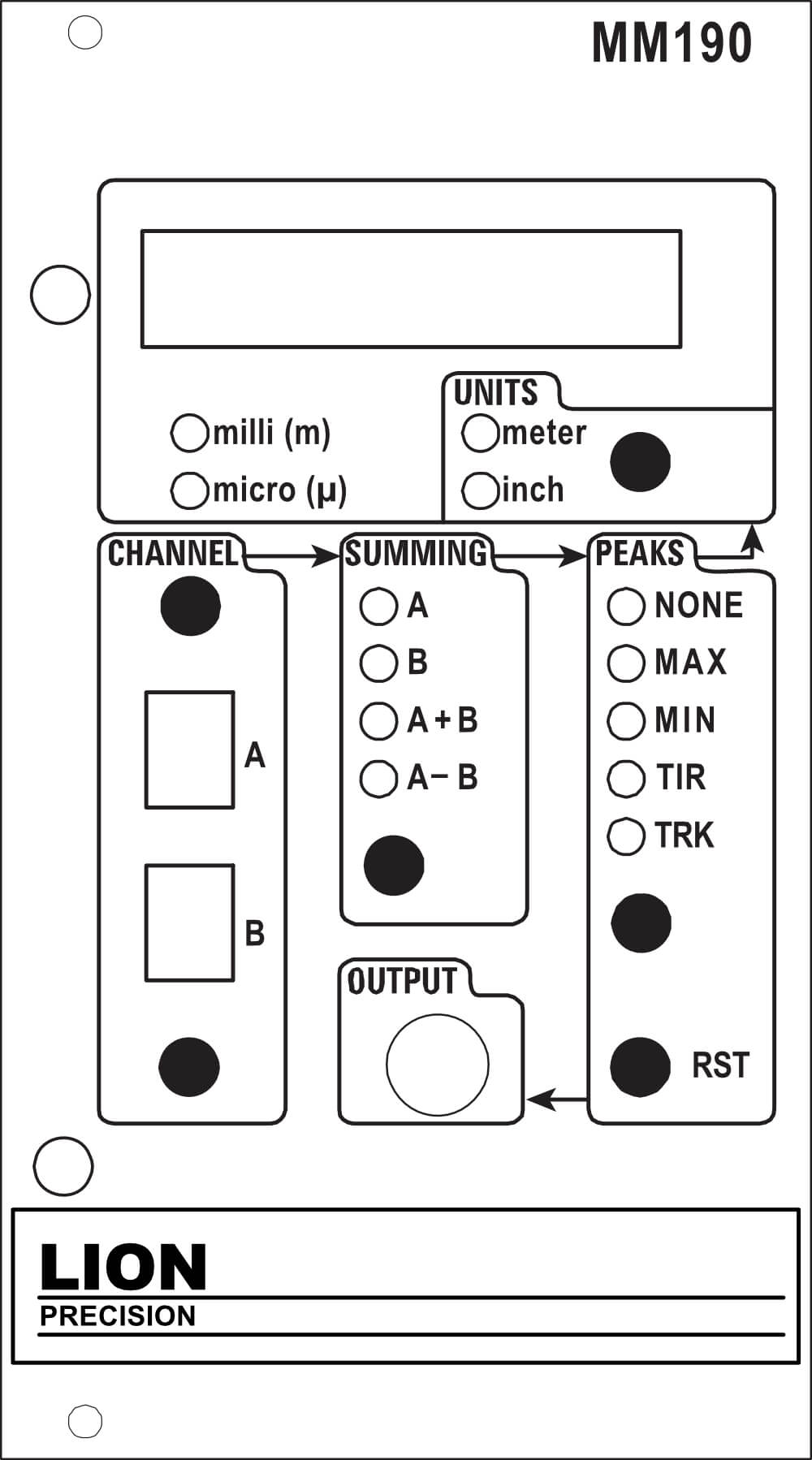
The MM190 Module displays dimensional values derived from sensors within an Elite Series system. Any two channels can be summed and peak capture functions can be performed on an individual channel or a resulting sum. The displayed value is also provided as an analog voltage via a front panel BNC connector.
- Displays dimensional units derived from sensor output voltages
- Selectable input channels
- Sum and Difference of any two channels
- Peak capture functions
- Metric/Inch unit selection
- Analog voltage output proportional to displayed value
Setup
Pressing the appropriate button repeatedly rotates through selections.
- Select sensor channels for A and B
- Select individual channel to be displayed (A or B) or the sum or difference of A and B
- Select a peak function
- Select metric or inch units
Display Units
The MM190 measures the analog voltage from the selected sensor channel and uses digital signal processing to perform any summing and/or peak capture functions. The result is converted to actual dimensional units for display. The multiplier indicators (milli, micro) combined with the Metric or Inch units indicate the dimensions of the displayed value. The button selects either Metric or Inch units. The multipliers are not selectable; they are selected by the system based on the calibration values of the displayed channel.
Channel Selection
Any existing sensor channel can be selected for A or B.
Summing Options
A and B can be displayed independently or combined as a sum or a difference.
Peaks
Five options are available:
- NONE – Display is real-time value of input channels.
- MAX – Displays the most positive value since the Reset (RST) button was pressed.
- MIN – Displays the most negative value since the Reset (RST) button was pressed.
- TIR – Displays the maximum difference between the MAX and MIN values since the Reset (RST) button was pressed. TIR is always a positive value.
- TRK – Tracking TIR displays the current maximum difference between the MAX and MIN values. When the TIR value is reduced, the displayed value will decay to the lower value within approximately one second.
Analog Output (BNC)
The analog voltage output from the MM190 BNC connector is scaled the same as the BNC output voltage from the selected sensor channels. For example, if the sensor channels are scaled at 1 V/1 μm, the MM190 will also scaled at 1 V/1 μm.
When two channels are summed, the MM190 BNC output voltage is divided by two. For example, summing sensor channels at 1 V/ 1μm each will produce an MM190 output voltage scaled at 0.5 V/1 μm. This allows both sensor channels to operate at full ±10 V without exceeding the ±10 V of the MM190.
MM190 Specifications
| BNC Output Scaling Error: | -0.3% |
| Internal Scaling Error: | 0.2% |
| Difference Error: | 0.2% |
| Summing Error: | 0.2% |
|
Tracking TIR Error Relative to Frequency: (not recommended below 100Hz) |
10 Hz: -15.0% 100 Hz: ±0.3% 1 kHz: ±1.5% 5 kHz: ±4.0% |
| TIR Error Relative to Input | DC: -15.0% |
| Frequency: |
1 kHz: ±1.3% 5 kHz: ±4.0% |
| Peak Droop: | 1 mV/15 seconds |
| BNC Output Impedance: | 150 Ohms |
Elite Series Enclosures
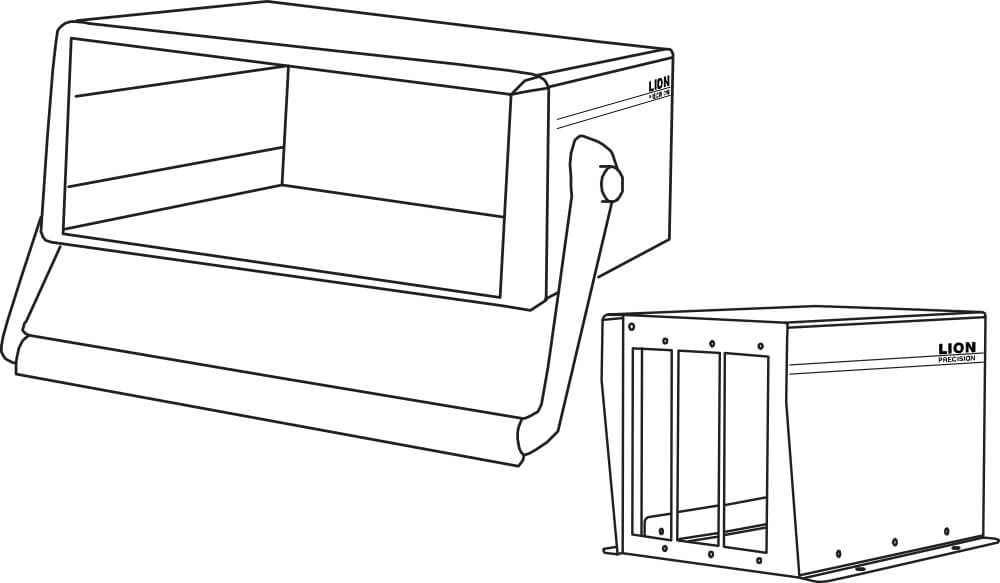
Elite Series enclosures provide housing and critical signals to Elite Series modules. Sensor output signals are available via a rear-panel high-density connector which is configured for direct connection to National Instruments™ data acquisition hardware.
The specific Elite Series enclosure model number indicates the maximum number of slots available for plug-in modules as well as other features:
| Model | Number of Module Slots | Input Power | Tin-up Handle | Mounting Flanges |
|
EN191 |
1 | ±15 VDC | No | Yes |
| EN192 | 2 | ±15 VDC | No | Yes |
| EN193 | 3 | ±15 VDC | No | Yes |
| EN196 | 6 |
100-250 VAC 50/60 Hz |
Yes | No |
| EN198 | 8 |
100-250 VAC 50/60 Hz |
Yes | No |
| Model | Power Input | Note |
| EN191, EN192, EN193 |
±15 VDC ±5%, 400mA Maximum (A power supply is included with orders) |
To maintain maximum resolution use a linear power supply or a power supply with switching frequency greater than 100 kHz such as Lion Precision Power Supply P014-5040. To maintain CE compliance, use the included power supply or equivalent CE compliant model. |
| EN196, EN198 |
100-250 VAC, 50/60 Hz, 250 VA Maximum |
EN191, EN192, EN193 Power Connector
| Pin | Connection |
| 1 | Ground |
| 3 | -15 VDC |
| 4 | +15 VDC |
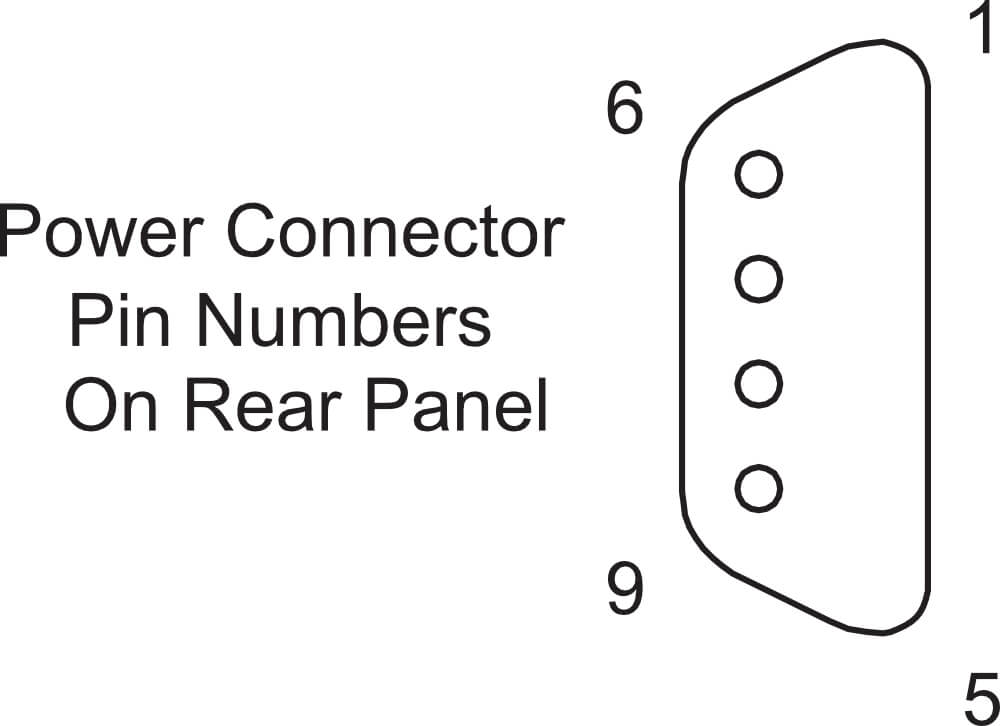
EN191, EN192, and EN193 systems include an external power supply. The supply has a connector which allows direct connection to the enclosure.
This supply features a high-frequency (100kHz) switching supply. The high switching frequency allows the sensing modules to operate at maximum resolution.
| DC Output Voltage |
+15 VDC ; 2.0 A -15 VDC ; 1.0 A |
| AC Input Voltage |
100-240 VAC, 50/60 Hz, 1.35 A max |
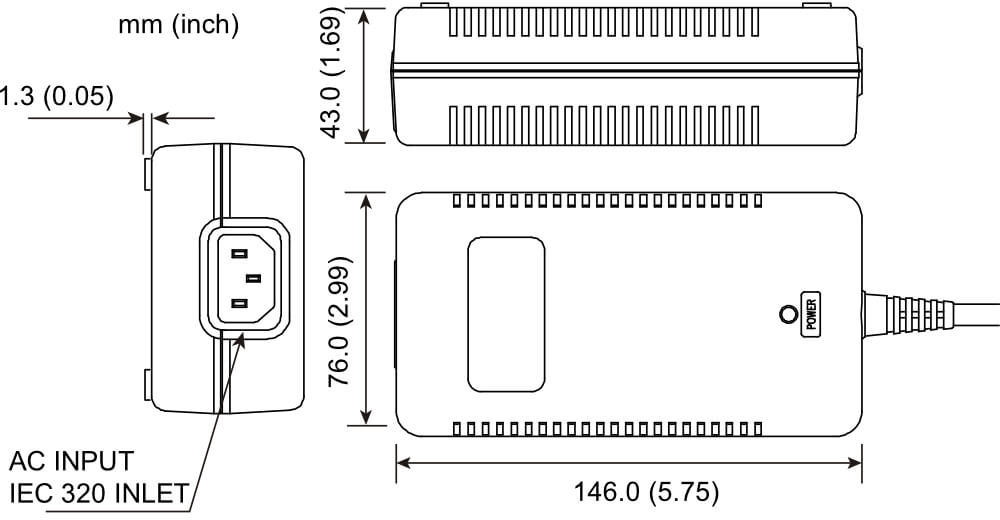
DAQ Connector Pinout
All unlisted pins are reserved for proprietary use by Lion Precision and should not be connected to external contacts.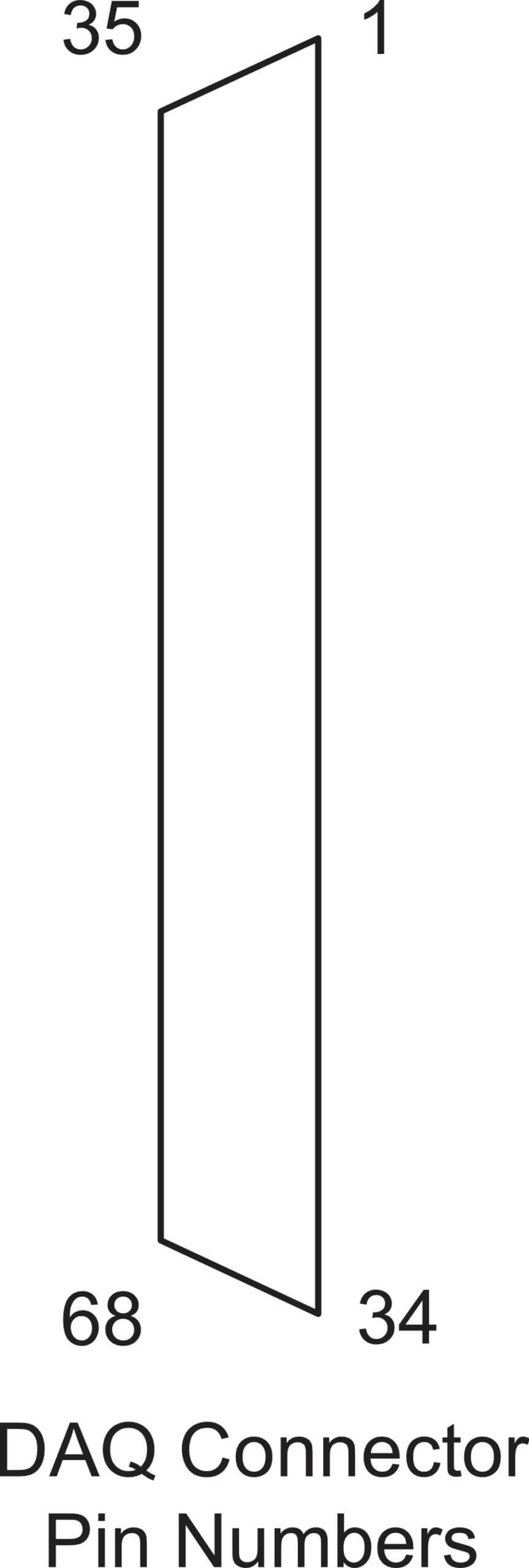
| Pin | Output Signals |
| 11 | Encoder |
| 12, 12, 15, 18, 53 | Digital Ground |
| 29, 32, 64, 67 | Analog Ground |
| 23 | – Analog Out; Channel 8 |
| 25 | + Analog Out; Channel 7 |
| 26 | – Analog Out; Channel 6 |
| 28 | + Analog Out; Channel 5 |
| 30 | + Analog Out; Channel 4 |
| 31 | – Analog Out; Channel 3 |
| 33 | + Analog Out; Channel 2 |
| 34 | – Analog Out; Channel 1 |
| 57 | + Analog Out; Channel 8 |
| 58 | – Analog Out; Channel 7 |
| 60 | + Analog Out; Channel 6 |
| 61 | – Analog Out; Channel 5 |
| 63 | – Analog Out; Channel 4 |
| 65 | + Analog Out; Channel 3 |
| 66 | – Analog Out; Channel 2 |
| 68 | + Analog Out; Channel 1 |
Mechanical Specifications: EN191, EN192, EN193
| Model | A | B | C |
| EN191 |
3.33″ 84.6 mm |
2.606″ 66.2 mm |
3.806″ 96.7 mm |
| EN192 |
4.73″ 120.1 mm |
4.006″ 101.8 mm |
5.206″ 132.2 mm |
| EN193 |
6.13″ 155.7 mm |
5.406″ 137.3 mm |
6.606″ 167.8 mm |
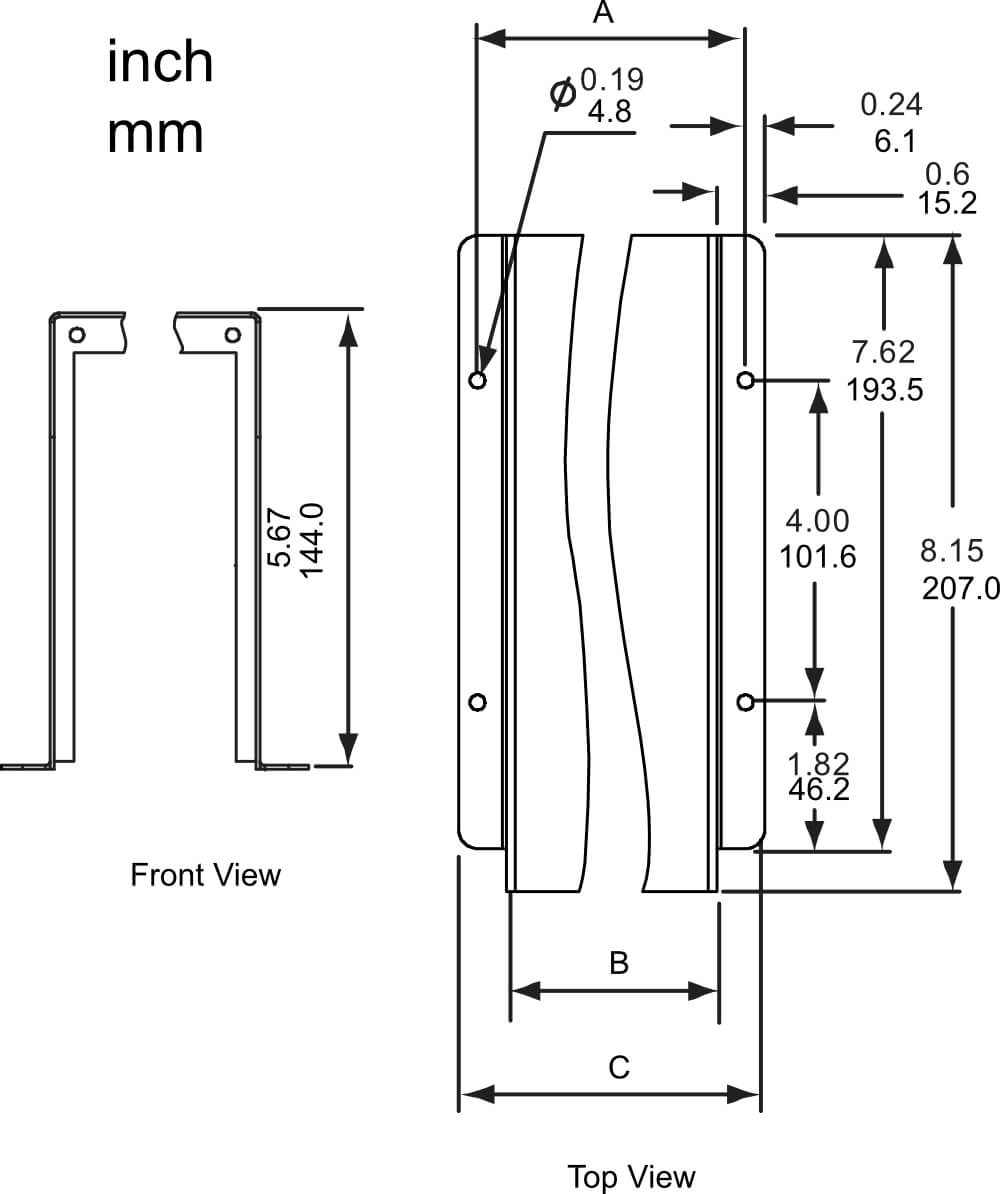
Mechanical Specifications: EN196, EN198
| Model | A |
| EN196 |
10.1″ 257 mm |
| EN198 |
14.3″ 364 mm |
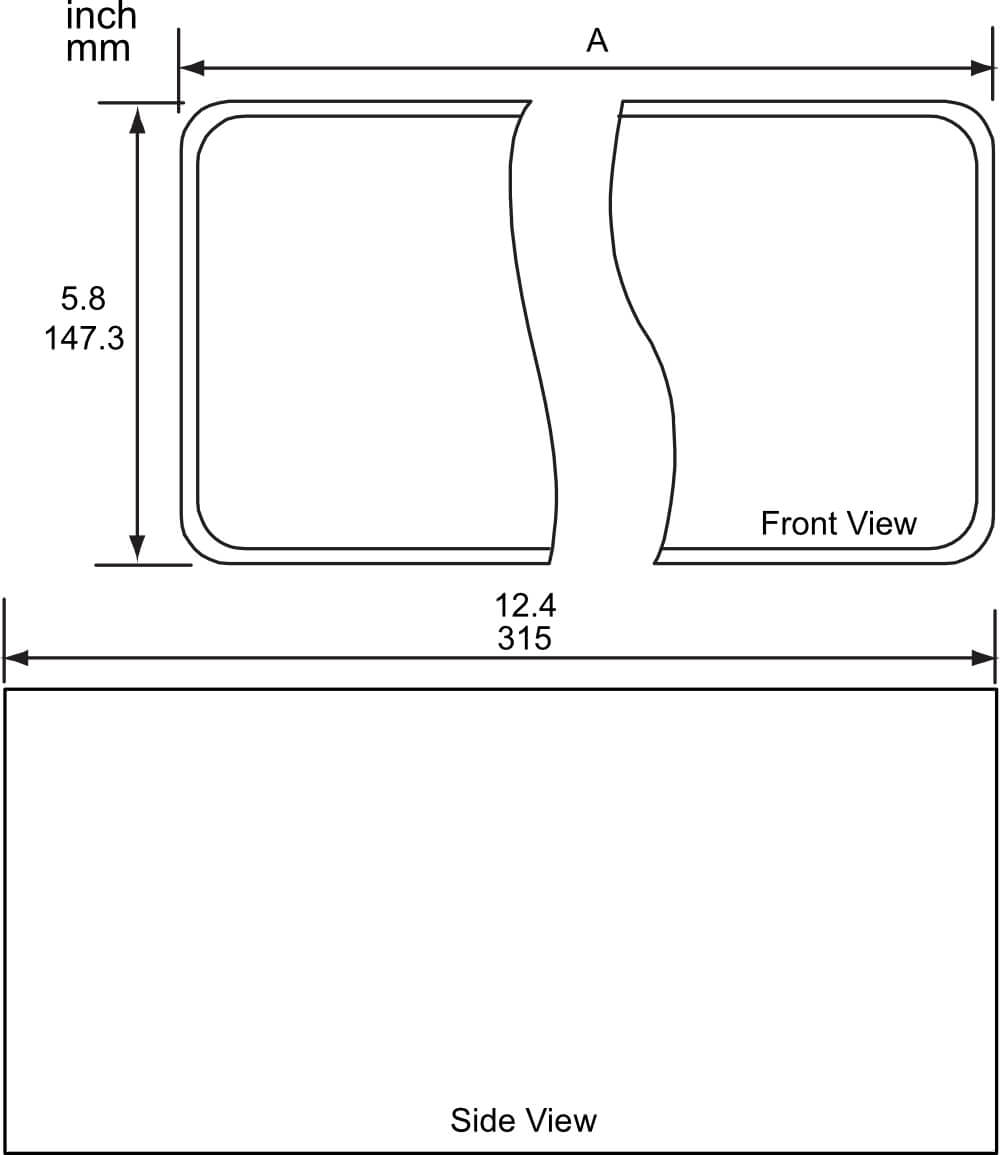
ACCESSORIES: Air-Bearing C-LVDT: Capacitive LVDT-Type Contact Sensor
The Air-Bearing C-LVDT converts a capacitive sensor using a standard capacitive probe into a high-precision contact displacement sensor similar to an LVDT. The capacitive probe is installed in the top of the C-LVDT body where it measures the location of a target connected on the inside end of the stylus. The C-LVDT uses a linear air-bearing for nearly frictionfree movement of the stylus, and the porous carbon air bearing is square to prevent stylus rotation. Adjustable air pressure for extending the stylus provides for contact forces less than one gram, and the C-LVDT features a retraction port through which application of air pressure will retract the stylus.
The C-LVDT uses an interchangeable diamond tip. Diamond has been selected over ruby for the following reasons:
- Low Friction – Side forces cause less lateral deflection from moving targets and less hysteresis on direction reversal.
- Highly Polished Surface – Diamond accepts and holds a high polish, minimizing the possibility of scratching the measured surface.
- Minimal Wear – Increased accuracy and longer life.
Contact Force Adjustment There is a contact force adjustment screw located on the end of the probe body near the cable exit. Use a 1/16″ hex key to turn the adjustment clockwise to increase the contact force or counter clockwise to decrease it. Contact force is also a function of the air pressure applied to the C-LVDT. To maintain constant contact force, supplied air pressure must be held constant.
Air Exhaust
The 0.1″ slot around the body near the top of the C-LVDT is where air is exhausted. Do not clamp the C-LVDT over this ring. The ring must remain at least partially clear at all times for proper operation of the C-LVDT.
Specifications
| Measurement Range | 0.5 mm, 0.020 inch |
| Contact Force | 0.2 g to 100 g |
| Radial Stiffness | < 0.25 μm/g |
| Bearing | Linear, porous air bearing |
| Diamond Tip |
Radius: 3.175 mm, 0.125 inch Mount: 4-48AGD Thread |
| Weight of Moving Mass | 4.2 g |
| Air Connection | 1/16 inch ID flexible tubing |
| Air Consumption | 3-7 lpm, 0.10-0.25 cfm |
| Operating Air Pressure | 420-480 kPa, 60-70 psi |
| Air Requirement | Dry, filtered to less than 5 μm particle size |
Mechanical Detail
